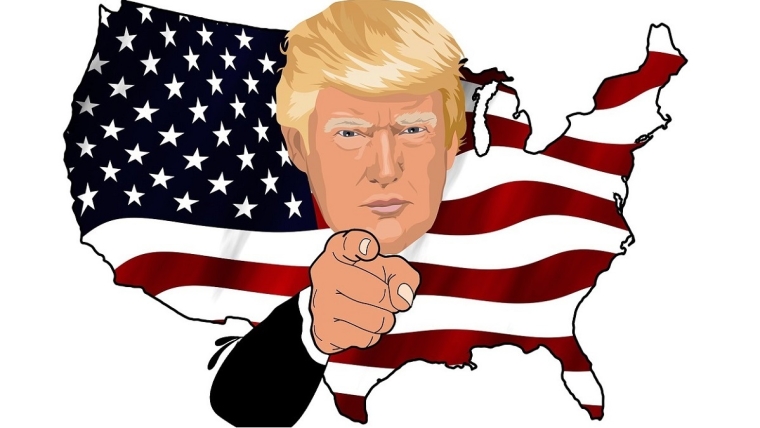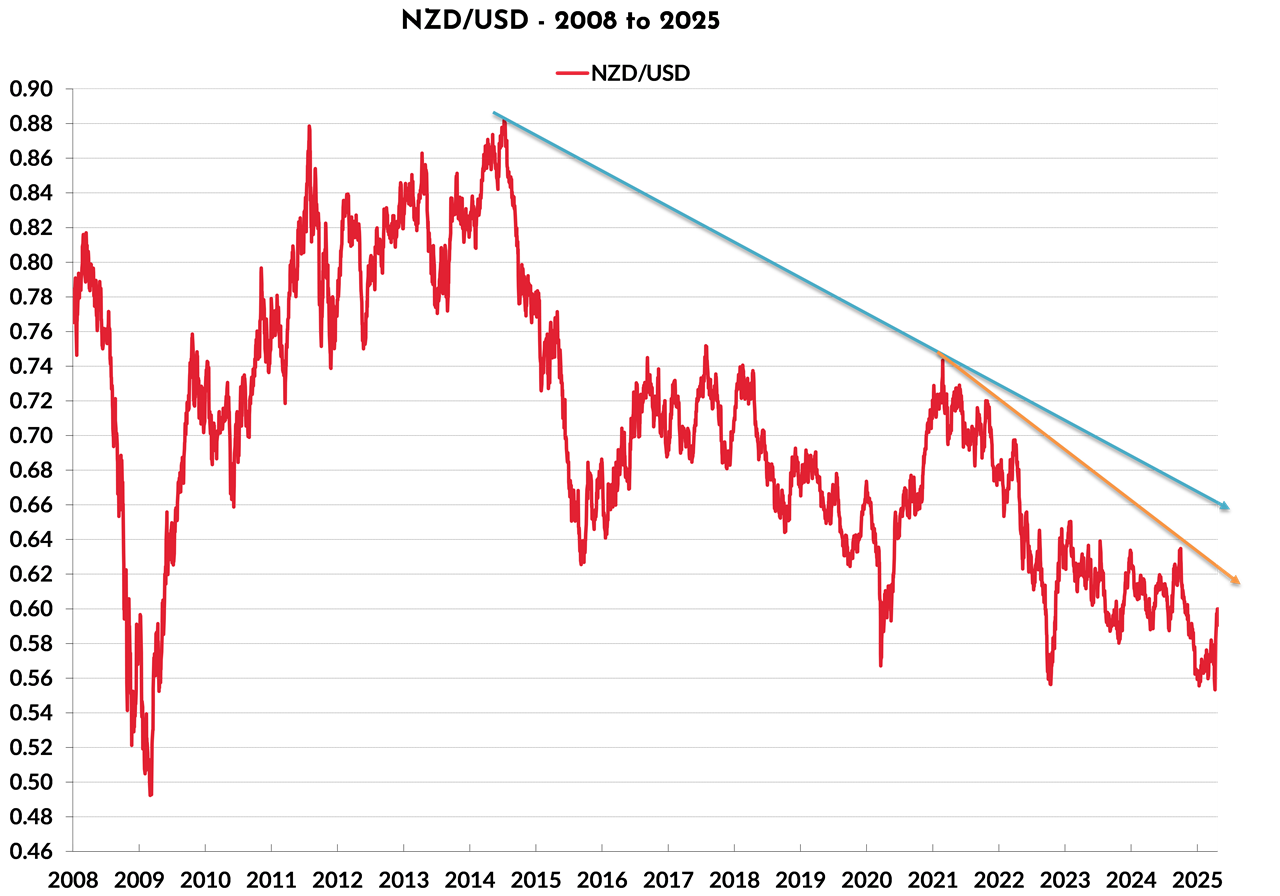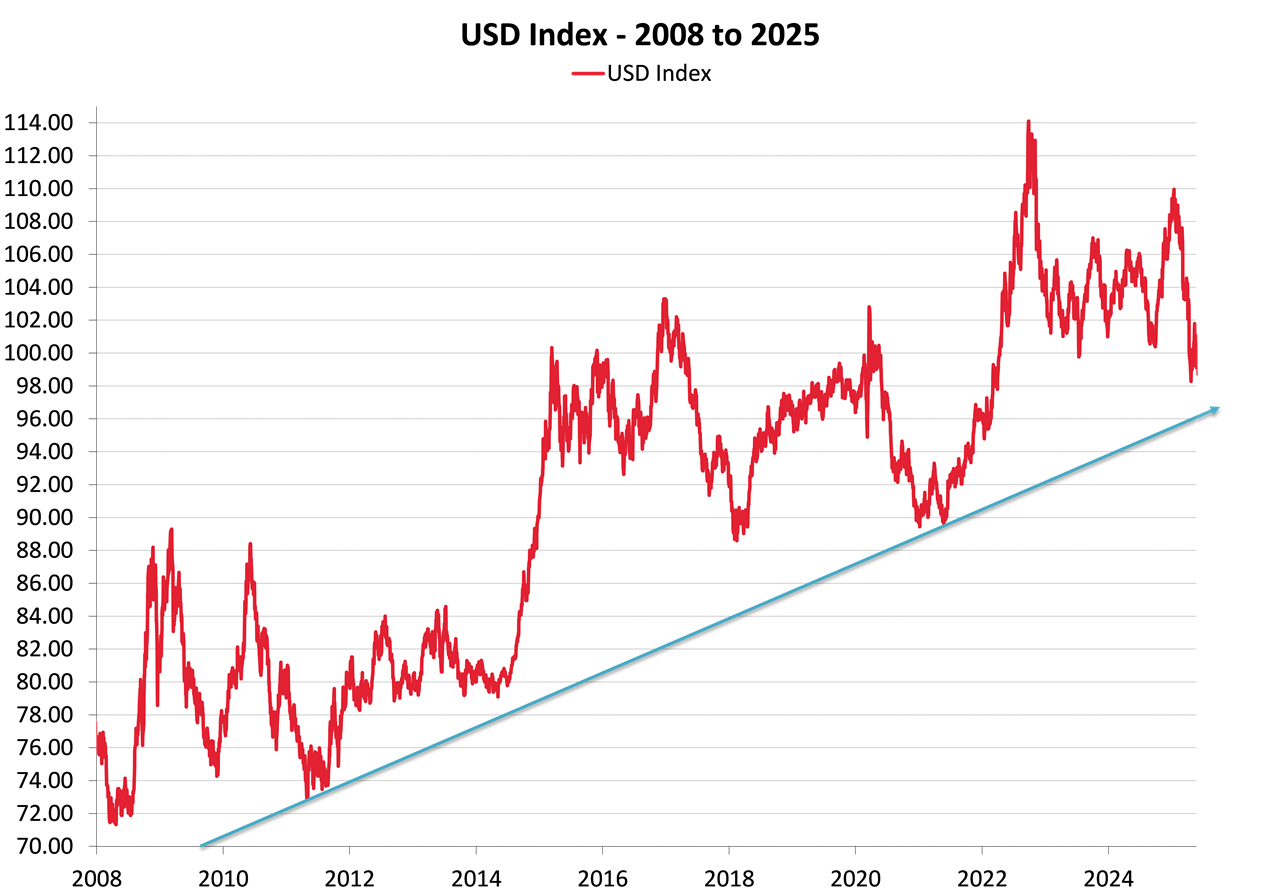
Summary of key points: -
- US dollar sold on threats to the Federal Reserve’s independence
- US bond markets start to price-in earlier interest rate cuts
- NZD and USD currency trends nearing critical junctures
US dollar sold on threats to the Federal Reserve’s independence
The US dollar continued on its relentless depreciation path over this last week, selling of the USD boosted by threats to the Federal Reserve’s independence. President Donald Trump once again politicising the Fed with his typical threats and bullying, saying that if Chair Jerome Powell will not lower interest rates, he will replace him with a new Chair who will.
Direct political interference in the most important institution that the financial and investment markets revolve around was a red rag for the currency markets. The USD Dixy Index plummeted to new record three-year lows on 28th June of 96.65, however it subsequently recovered back up to 97.00 after the White House confirmed that there were no immediate plans to replace Chair Powell earlier than his May 2026 end of term date. Earlier, there was speculation in the markets that an appointment of a replacement for Powell could take place as early as September this year, effectively creating a “shadow’ Chairman. Such an appointment would undermine the position of the Fed as the Trump appointed replacement espouses the need for lower interest rates. Donald Trump may have had two decisive victories recently, both home and abroad, with the Israel/Iran ceasefire and the US Supreme Court providing him yet more powers. However, he has backed-off creating havoc at the Fed by appointing Powell’s replacement early.
There were hints earlier last week that Trump’s administration was bringing political pressure to bear on individual Federal Reserve members to cut interest rate sooner rather than later. Three FOMC voting members, Chris Waller, Austan Goolsbee and Michelle Bowman all making speeches calling for a cut in the Fed Funds interest rate at their next meeting on 30th July. The evidence of political pressure (all three were appointed in Trump’s first term) was the fact that Michelle Bowman is a renowned “hawk”, so very mysterious that she should suddenly change her tune and to be now calling for interest rate cuts.
The media have speculated that there are five candidates are in Trump’s reckoning to be the next Fed Chair, including his current Treasury Secretary Scott Bessent. Whilst Scott Bessent would be well qualified to take the role, it is unlikely that Trump would move him away from his main job to reduce the US Government’s increasing budget deficits and debt mountain. The most likely candidate is 55-year old financier/banker Kevin Warsh, who served as a member on the Federal Reserve from 2006 to 2011. Mr Warsh was the youngest ever Fed member when he was appointed in 2006.
Trump, the media and the financial markets have all erroneously placed too much importance on the power of the Fed Chair to determine interest rates on his/her own. Jerome Powell chairs the FOMC meetings and is the spokesperson in front of the media, however his vote on the 19-member monetary policy committee is equal to all other members. He has no casting vote or special powers over interest rate decisions. It still requires a majority vote within the committee to hold rates or make a change.
All in all, the Fed Chair’s position was something of a storm in a tea-cup. However, the erratic Trump directly interfering in the workings of the independent Federal Reserve was just another reason for foreign investors to further reduce their confidence in the US Government and the US economy. The “Sell America” trade is still very much in train as evidenced by the continuing US dollar depreciation.
US bond markets start to price-in earlier interest rate cuts
Both US 10-year and two-year Treasury Bond yields have decreased significantly over the last three weeks. The 10-year yield dropping from 4.52% on 9th June to 4.27% currently. The two-year bond yield falling away from 4.05% three weeks ago to 3.74% today. The lower pricing reflecting weaker US economic data and a growing expectation that the import tariff increases will not push up inflation later in the year as much as many first thought. There are no real signs of higher imported product prices coming through in monthly CPI and PCE inflation data as yet. However, there are reports that US retail distribution warehouses are starting to re-ticket product selling prices higher by 5% to 10% due to tariffs. The Fed remains super cautious and are not changing interest rates (despite the annual inflation rate reaching their target of 2.00%) as they say they do not know to what extent the unknown tariff percentages will increase inflation. The strong counter-argument to the Fed is that Trump’s tariffs are essentially a retail tax and they should be “looking through” such price increases as a once-off that is not caused by normal demand and supply market forces in the economy. It is a tax on US consumers to help Trump reduce his budget deficit that he wrongly thought the foreign exporters would pay.
So, the wait and see game continues on the tariff deals and therefore the timing of the next Fed cut to interest rates. A China/US trade deal does appear close to finalisation and the race is on to agree something with the Europeans before the 9th July deadline date. Apparently, there are 10 trade deals about to be signed, so the Fed may not have to wait much longer to calculate the tariff impact on inflation. What should always be remembered in these debates, as to how much tariffs will increase US inflation, is that imported products such as I-Phones, computers, clothing, footwear and toys are all tiny weightings in the CPI Index. The CPI is totally dominated by housing and health cost (over 60% combined).
The implications for the NZ dollar value from the continuing reduction in US market interest rates is that the interest rate differential is now being closed-up from both sides. Stronger New Zealand GDP growth data (well above RBNZ forecasts) and inflation on the rise again, strongly suggests that the RBNZ will not be cutting the OCR any further at their 9th July meeting. New Zealand two-year bond yields are trading at 3.30% and going no lower. US two-year yields are 3.74% and headed lower as the US economic data continues to print on the softer side. Over recent years, the fact that NZ interest rates have been below US interest rates has prevented the Kiwi dollar from appreciating on its own account, due to the speculative buyers of the Kiwi not being prepared to “pay away” the positive forward points. When the forward points reduce to close to zero, the disincentive to buy the Kiwi is removed.
US Non-Farm Payrolls jobs data for June is being released this Friday night 4th July and already the consensus forecasts are pointing to a very weak number between +100,000 to +129,000. What is highly likely is that the previous month’s +139,000 result for May will be subsequently revised lower. US interest rates will move lower again on a soft figure as the markets start to price-in the Fed cutting interest rates in July on the sharply deteriorating employment side of their mandate.
The reason why Donald Trump has been laying into Fed Chair Powell to cut interest rates is that the US Government is issuing new debt and rolling over maturing debt at historically high 4.50% to 5.00% fixed interest rates. The higher issuance yields just makes the annual interest bill increase exponentially, further increasing and cementing-in the US’s now structural fiscal (budget) deficit. Collection of Trump’s import tariffs is absolutely chicken-feed against the ballooning Government interest costs.
Is the US headed for a Government debt crisis? The FX markets, in selling the US dollar so aggressively, are telling us that this risk has certainly increased under the wrecking ball that is Donald Trump. The depreciation of the US dollar is also the FX markets telling us that the Fed will be forced by the economic evidence to cut their interest rates again on 30th July.
NZD and USD currency trends nearing critical junctures
Since 2015 when the NZ dollar peaked against the US at 0.8800 on a weak USD and sky-high dairy commodity prices at the time, the NZD/USD exchange rate has broadly remained on a long-term downtrend (refer to the chart below). The Kiwi dollar appreciated to the 0.7500 level in the 2016 to 2018 period, and again in 2021, however could not sustain further gains.
A further significant pattern in the historical NZD/USD currency movements is that it does not remain below 0.6000 for very long. The recent recovery upwards to trade back above 0.6000 is potentially starting to test the intersection of the two downtrend lines at 0.6150 and 0.6600. A break above 0.6150 over coming weeks would certainly change the technical/chart related signals for the Kiwi dollar to a much more positive future outlook.
The overall value of the US dollar has been the dominant driver of NZD/USD exchange rate movements over the last three years. Whether the Kiwi dollar can break to 0.6150 downtrend line and go on to test the 0.6600 level seems totally dependent on how much further the US dollar will depreciate over coming months.
Standing back from the day-to-day noise of FX markets, a long standing advisory client recently asked us why is it that our exports are currently booming and that domestic economic activity (housing and retail) is very subdued? The answer we provided (which he expected) was that the Kiwi dollar is very low – boosting export returns and restricting domestic spending/investment due to high import costs. The optimal currency value equilibrium for New Zealand to have a more balanced economy is clearly the mid to high 0.6000’s.

The US dollar’s movements over the last 17 years has been a clear uptrend (refer to the USD Index chart below). At its current rate of depreciation the USD Dixy Index will intersect the long-term uptrend support line at 96.00. That inflection point is not that far away (currently 97.00) and a clear break below 96.00 could well signal to many investors and traders around the world that the strong US dollar is a phenomenon of the past.
Our consistent view over the last 12 months has been that the US dollar will depreciate to its 95.00 average rate of the 2015 to 2020 period. The current USD depreciation is certainly on target to achieve that forecast. The high likelihood of the US cutting their interest rates over the second half of 2025 when most other central banks have finished cutting (RBA excepted), does suggest that even a lower USD value towards 90.00 on the Index is a real possibility. The last time the USD Index was 90.00, the NZD/USD rate was trading above 0.7000 (in 2021).

Daily exchange rates
Select chart tabs
*Roger J Kerr is Executive Chairman of Barrington Treasury Services NZ Limited. He has written commentaries on the NZ dollar since 1981.
1 Comments
Interesting article. I believe weakening the US dollar is part of the current administrations on-shoring strategy. It makes imports more expensive and exports less so. In the long run less reliance on the US dollar as the only reserve and trading currency should make the global economy more resilient and able handle disruptions in trading patterns more easily.
The risk to the US - supposedly - is falling demand for US Treasuries - but given that the US is a fiat currency issuer this problem may be over blown. The Fed can always buy US bonds itself when it needs to - as it has done multiple times in the last 20 years without any significant problems.

We welcome your comments below. If you are not already registered, please register to comment.
Remember we welcome robust, respectful and insightful debate. We don't welcome abusive or defamatory comments and will de-register those repeatedly making such comments. Our current comment policy is here.